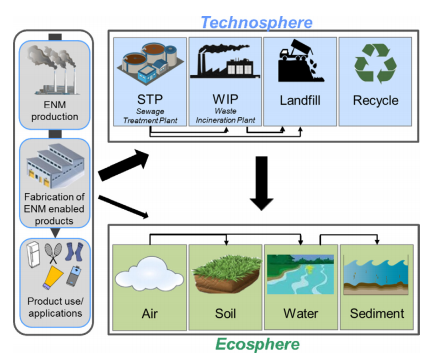The life cycle analysis allows to quantify the environmental impact of a product, a service or a process and to identify direct or indirect exposures.
We need to know:
- the modes and the importance of the potential rejections in the environment,
- the mechanisms of distribution and transformation in the air, in the water and in the ground,
- the preferential places of accumulation and the conditions of persistence and degradation,
- the ecotoxicity for the flora and the fauna and the mechanisms of potential transfer in the food chain.
According to a study in 2013, about 63 to 91 % of global manufactured nanoparticle production in 2010 (3x105 tons) ended up in landfills. The remaining was being released into soils (8 - 28 %), water bodies (0.4 - 7 %), and atmosphere (0.1 - 1.5 %) [A.A. Keller et al., Journal of Nanoparticle Research 15 (2013)].
The form in which nanomaterial are released into the environment will depend on the product life cycle: pure during the production, link to others compound throughout the use and to environmental compounds during the entrance in the ecosystems [M. Nowack et al., The International Journal of Life Cycle Assessment 17 (2012) 655-665].
Several studies have shown than nanomaterials could be release into the environment:
- involuntary due to their use in some products such as paints, cosmetics or textiles [A.A. Keller et al., Journal of Nanoparticle Research 15 (2013) / M. Nowack et al., The International Journal of Life Cycle Assessment 17 (2012) 655-665],
- voluntary in the case of activities linked to agriculture or to a remediation of polluted ecosystems [M.M. Khin et al., Energy and Environmental Science 5 (2012) 8075-8109 / A. Servin et al., Journal of Nanoparticle Research 17 (2015)].

Manufactured nanomaterial life cycle into the environment [T.Y. Sun et al., Environmental Pollution 185 (2014) 69-76].


